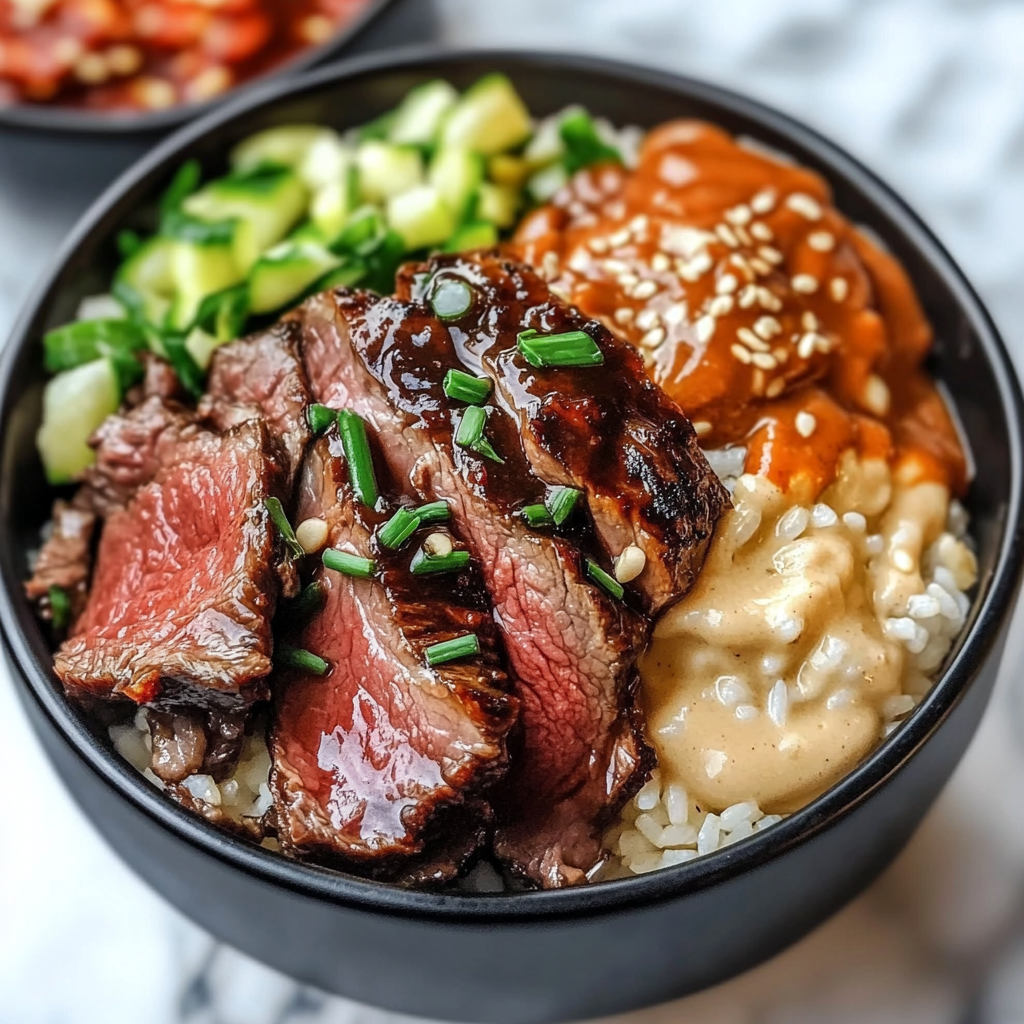Sharing is caring!
Korean BBQ Bowls: Irresistible Flavor-Packed Steak with Creamy Sauce
If you’re craving bold, savory flavors with a touch of sweetness, these Korean BBQ bowls are your answer. Packed with tender steak, crisp veggies, and a creamy sauce, this dish delivers restaurant-quality taste right at home. Whether you’re meal prepping or hosting a casual dinner, these bowls are a guaranteed crowd-pleaser.
What sets this recipe apart is its perfect balance of textures and flavors. The marinade infuses the steak with umami-rich depth, while the creamy sauce adds a cooling contrast. For a lighter twist, try pairing it with our apple oat muffins as a side.
I’ve perfected this recipe over years of testing, adjusting the spice levels and sauce consistency for maximum enjoyment. The key lies in the marinade—don’t skip it! Let’s dive into how you can recreate this Korean-inspired masterpiece in your kitchen.
Table of Contents
Ingredients List
- 1 lb flank steak, thinly sliced
- ¼ cup soy sauce (low-sodium preferred)
- 2 tbsp brown sugar
- 1 tbsp sesame oil
- 3 cloves garlic, minced
- 1 tbsp ginger, grated
- 1 tbsp rice vinegar
- 1 tbsp gochujang (Korean chili paste)
- 1 tbsp honey
- 2 green onions, chopped
- 1 tbsp toasted sesame seeds
- 2 cups cooked white or brown rice
- 1 cup shredded carrots
- 1 cup thinly sliced cucumber
- ½ cup kimchi (optional)
Creamy Sauce:
- ½ cup mayonnaise
- 2 tbsp Sriracha sauce
- 1 tbsp lime juice
- 1 tsp honey
Timing
- Prep Time: 15 minutes
- Marinating Time: 30 minutes (or up to 2 hours for deeper flavor)
- Cook Time: 10 minutes
- Total Time: 55 minutes (including marination)
Step-by-Step Instructions
Creating these irresistible Korean BBQ bowls is easier than you think. Follow these simple steps to achieve perfectly marinated steak and creamy sauce every time.
Step 1: Marinate the Steak
Start by thinly slicing your steak against the grain. In a bowl, mix soy sauce, brown sugar, minced garlic, grated ginger, sesame oil, and a splash of rice vinegar. Add the steak slices, ensuring they’re fully coated. Let it marinate for at least 30 minutes—or overnight for deeper flavor.
Step 2: Prepare the Creamy Sauce
Whisk together mayonnaise, gochujang (Korean chili paste), honey, lime juice, and a pinch of salt. Adjust the spice level to your preference. Set aside.
Step 3: Cook the Steak
Heat a skillet or grill pan over medium-high heat. Cook the marinated steak in batches for 2-3 minutes per side until caramelized and tender. Avoid overcrowding the pan to ensure even cooking.
Step 4: Assemble the Bowls
Layer cooked rice in bowls, then top with the Korean BBQ steak, crisp veggies (like shredded carrots, cucumbers, or kimchi), and a drizzle of the creamy sauce. Garnish with sesame seeds and green onions.
Step 5: Serve & Enjoy
Mix everything together for a burst of flavor in every bite. Pair with a side of banana cream pie for a sweet finish!
Nutritional Information
These Korean BBQ bowls are not only delicious but also packed with balanced nutrition. Here’s a breakdown per serving (approx. 1 bowl):
- Calories: 520 kcal
- Protein: 32g (great for muscle repair)
- Carbs: 45g (includes fiber-rich rice and veggies)
- Fats: 22g (healthy fats from sesame oil and mayo)
- Sodium: 800mg (opt for low-sodium soy sauce if needed)
For a lighter twist, try substituting white rice with oat-based alternatives or cauliflower rice. The marinade’s ginger and garlic also offer anti-inflammatory benefits, as highlighted in this slow-cooked beef guide. Craving more protein? Add a soft-boiled egg like in this barbecue chicken recipe.
Healthier Alternatives for the Recipe
Love Korean BBQ bowls but want a lighter twist? Try these simple swaps to keep the flavor bold while cutting calories and boosting nutrition.
Leaner Protein Options
Swap traditional ribeye steak with leaner cuts like sirloin or flank steak. For a plant-based version, marinated tofu or tempeh works beautifully—check out this vegan marinade inspiration for ideas.
Low-Sugar Sauce
Reduce sugar in the BBQ sauce by using coconut aminos or a sugar-free sweetener. Pair it with a creamy yogurt-based drizzle instead of mayo for extra tang.
Veggie Boost
Load up on roasted or pickled veggies like zucchini, carrots, or kimchi. For crunch without carbs, try jicama or cucumber ribbons. Need more fiber? Add a scoop of oat-based toppings for texture.
Whole Grains
Replace white rice with quinoa, cauliflower rice, or a blend of brown rice and barley. These add fiber and nutrients while keeping the bowl hearty.
Serving Suggestions
Elevate your Korean BBQ bowls with these pairing ideas for a complete meal experience.
Perfect Side Dishes
Serve with classic Korean sides like spicy cucumber salad or steamed bok choy. For a fusion twist, try crispy sesame kale chips.
Drink Pairings
Balance the richness with iced barley tea or a citrus-infused sparkling water. For a festive touch, a light vanilla-infused drink complements the smoky flavors.
Dessert Ideas
End with something refreshing like fruit-based desserts or a scoop of ginger ice cream. A drizzle of honey on nutty cookies adds a sweet crunch.
Common Mistakes to Avoid
Making Korean BBQ bowls is simple, but a few slip-ups can affect flavor and texture. Here’s what to watch for:
- Overcooking the steak: Thinly sliced beef cooks fast—just 1–2 minutes per side. Overcooking makes it tough. For tender meat, try techniques from this slow-cooked short ribs guide.
- Skipping the marinade: Even 30 minutes of marinating boosts flavor. No time? Massage the sauce into the meat before cooking.
- Using low-quality gochujang: Authentic Korean chili paste (like in this spicy chicken recipe) delivers depth. Check labels for artificial additives.
Pro tip: Balance sweetness in the sauce—too much sugar overwhelms the savory notes. Adjust with rice vinegar or sesame oil.
Storing Tips for the Recipe
Keep your Korean BBQ bowls fresh and flavorful with these storage hacks:
- Meal prep separately: Store steak, sauce, and veggies in airtight containers for up to 3 days. Reheat meat gently to avoid drying. Pair with no-bake sides for quick meals.
- Freeze for later: Portion cooked steak and sauce in freezer bags (up to 2 months). Thaw overnight, then refresh with a splash of broth when reheating.
- Revive leftovers: Toss cold rice in a hot pan with a bit of oil, or repurpose meat into savory pancakes or wraps.
For long-term sauce storage, pour extras into ice cube trays—perfect for single servings. Learn more about preserving fruity flavors here.
Conclusion
Korean BBQ bowls deliver an explosion of flavor with every bite, combining tender steak, vibrant veggies, and a creamy sauce that ties everything together. Whether you’re meal prepping or hosting a casual dinner, this dish is a crowd-pleaser. For more easy-to-make recipes, check out our apple oat muffins or chocolate chip muffins for a sweet finish.
FAQs
Can I use chicken instead of beef?
Absolutely! Thinly sliced chicken thighs work great and absorb the marinade well.
How do I store leftovers?
Keep components separate in airtight containers for up to 3 days. Reheat the steak gently to avoid overcooking.
Is there a vegetarian alternative?
Swap the steak for tofu or portobello mushrooms, and use a vegan mayo-based sauce.
Can I make this gluten-free?
Yes! Use tamari instead of soy sauce and ensure all other sauces are gluten-free certified.
What sides pair well with Korean BBQ bowls?
Kimchi, steamed rice, or a light cucumber salad complement the flavors perfectly.










